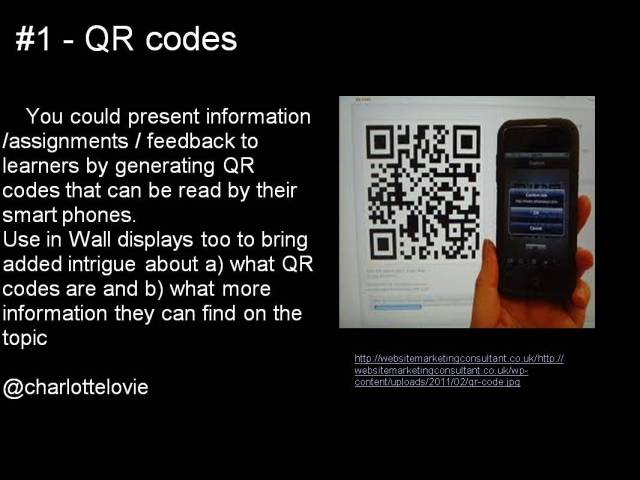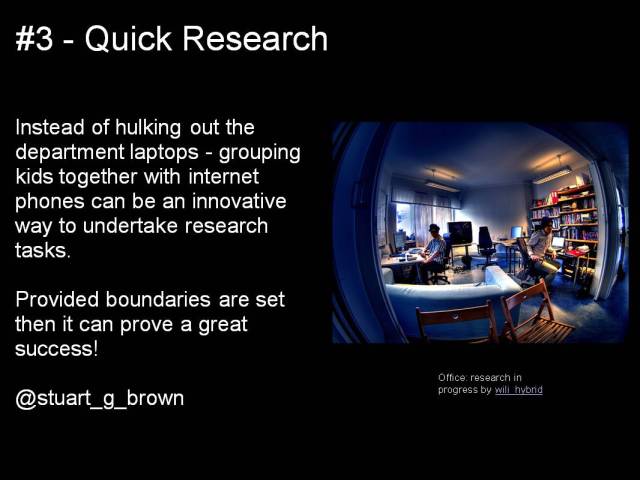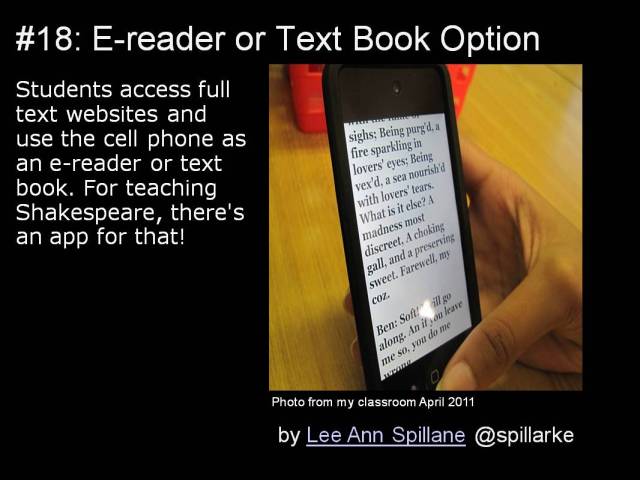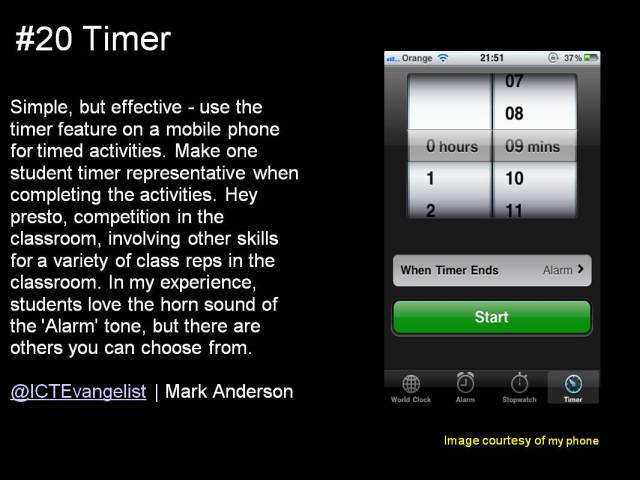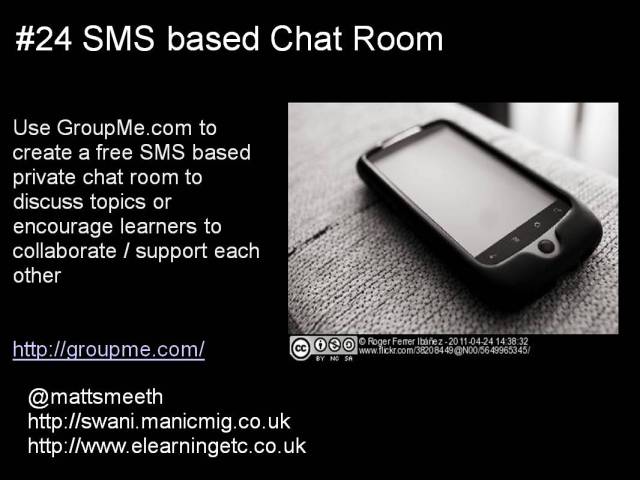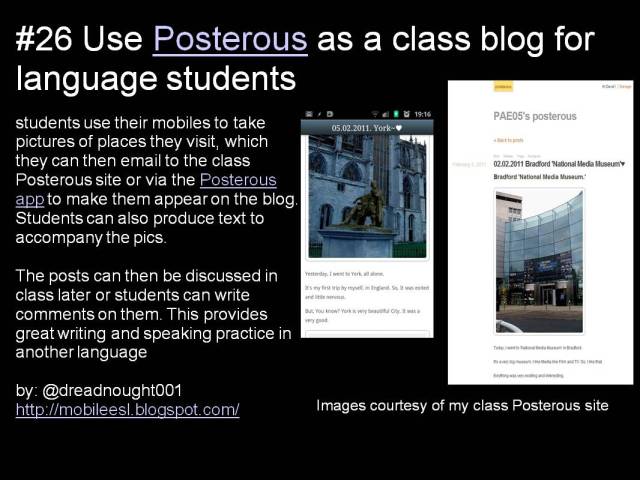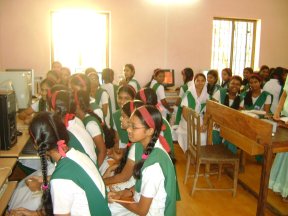Iqbal Quadir says mobiles fight poverty
Latest Entries »
The following slides are being uploaded from the presentation titled
“ 26 interesting ways to use mobile phones in classroom” under the creative commons license. Though the original count was 26 it has grown upto 29 through valuable additions by various contributors. The presentation itself is a valuable example of crowdsourcing. To contribute, please visit here.
Some other valuable ideas about the use of Mobile phones in classrooms can be accessed here:
- Smartphones in classrooms: It talks about various applications of the use of mobile phones in classroom for an interesting learning experience.
- “Educators Look at Using Cell Phones as Teaching Tools” The article features how cell phones are being used in Joe Wood’s science class at Somerset Middle School in Modesto, CA. [published in Aug 03, 2009, The Sacramento Bee – McClatchy-Tribune Information Services via COMTEX]
- “From Toys to Tools: Connecting Student Cell Phones to Education” This book is written by Liz Kolb, a doctoral student at the University of Michigan studying Learning Technologies. She is also an adjunct Professor at Madonna University and a former high school teacher and technology coordinator. Liz maintains a website called “CellPhonesInLearning.com” Inside Michigan Education conducted an interview with Liz that you can read online.
- Smartphones belong in classroom: an article by NY Times.
- Joe Dale’s tips on integration of technology into learning experiences.
We have also covered the issue of improvements in literacy in third world countries on our blog. We have discussed a few literacy projects by Google, TATA (India & Africa), Planet Read’s (India – “Same Language Sub-titling project“), Tastan (Senegal – Jokko Initiative).
A current report titled “Women & Mobile: A Global Opportunity” discussing the mobile phone gender gap in low and middle-income countries has presented some insight into the advantages of bridging the mentioned gap. The report suggests that:
Mobile phone ownership in low and middle-income countries has skyrocketed in the past several years. But a woman is still 21% less likely to own a mobile phone than a man. This figure increases to 23% if she lives in in Africa, 24% if she lives in the Middle East, and 37% if she lives in South Asia.
One of the important impacts of ICTs is on literacy and we will be covering a case from Pakistan about SMS for literacy project by Bunyad Foundation in collaboration with UNESCO and Mobilink (Pakistan telco).
A brief description about Bunyad’s projects by Pakistan Herald is reproduced here:
The schools established under the project were known as ILM NFPE centres and were supported by UNICEF starting with literacy and education in one district Bunyad has gradually expanded both in geographical areas of operation as well as the field of its activities. It is presently active in 18 districts of the province of Punjab and particularly in more than 2000 villages and its programs, in addition to literacy and non-formal education, include projects in such diverse fields as child labour, women empowerment for poverty alleviation, saving and micro credit community development, integrated farming and sanitation, health, reproductive health and environment. Bunyad has been working in approximately 5000 villages in 500 Union councils on various projects in Pakistan.
Bunyad’s work won it international recognition through UNESCO’s awards in contribution to literacy and education. The organization’s president was also awarded Aizaz-e-Fazeelat (Civil award) from president of Pakistan.
Pakistani mobile operator Mobilink, a subsidiary of Orascom, has learned a great deal about attitudes regarding women and mobile phones, especially as penetration rates soared in Pakistan over the last several years. In addition to creating a product tailored specifically for the women’s market several years ago, Mobilink has sought to demonstrate the power of mobile phones to improve literacy rates for adolescent girls in rural areas of Pakistan where reading materials are often scarce. Yet there is often resistance to girls’ having the independence that mobile phones symbolise.
For four months in 2009, Mobilink partnered with UNESCO and a local nongovernmental organisation (NGO), Bunyad, on a pilot project in a rural area of southern Punjab province involving 250 females aged 15-24 who had recently completed a basic literacy programme. Each of the girls was provided with a low-cost mobile phone and prepaid connection. Teachers were trained by Bunyad to teach students how to read and write using mobile phones. The company set up a system for the NGO to send out SMS messages in an effort to maintain and improve participants’ literacy, which often lapses because of inadequate access to interesting reading material. Crucially, the low-cost phones were enabled to send and receive messages in Urdu, the local language, rather than in English. The girls received up to six messages a day on a variety of topics including religion, health and nutrition, and were expected to practise
reading and writing down the messages and responding to their teachers via SMS. Monthly assessments of participants learning gains were conducted to assess impact.Programme organisers encountered considerable resistance on the part of parents and community leaders to the idea of allowing girls to have mobile phones, largely due to the conservative social norms of the area. This resistance began to soften, however, once people began to see the nature of the messages the girls were receiving and the benefits the programme conferred. Exams taken by the girls participating in the programme showed striking early gains in literacy, with the share of girls receiving the lowest scores dropping nearly 80%.
Participants and their families are even taking advantage of other features of the phones, including the calculator. While 56% of learners and their families initially maintained negative feelings toward the programme, 87% were satisfied with its results by the end. Families also appreciated the greater sense of security that being able to contact their daughters or wives provided. Users can pay US$6 to buy their phones at the end of the programme and continue receiving text messages, and Mobilink, UNESCO and Bunyad plan to expand the programme further.
The success of this programme demonstrates how mobile phones can be used to increase the reach and effectiveness of basic education programmes. It also illustrates the fact that suspicion of mobile phones can be overcome by showing parents and leaders how mobiles
can be used to transmit culturally sensitive information whilst increasing girls’ sense of security.
As reported by business recorder, Mobilink has planned to extend this pilot project further.
Uptil now, SMS have been perceived as a threat by academics and the discussion had always been centered around how to curb this nuisance during classrooms, as duly noticed by Micheal Trucano on his blog at World Bank. However m-learning initiatives are changing the landscapes of education. Trucano also referred to another interesting m-learning project from Pakistan. He notes that:
In Pakistan, some innovative folks are exploring how basic text messaging (SMS) can be used in the education sector to the benefit of people with even very low end mobile phones, leveraging the increasing high teledensities found in communities across the country.
Thinkchange Pakistan notes that:
The Asghar Mall College pilot project where 150 students who had their mobile phone numbers on file began participating in a daily vocabulary quiz exercise delivered by SMS. These young men from middle to lower middle class backgrounds were sent simple multiple-choice questions. Texts were addressed to each student individually, using the equivalent of a ’mail merge’ function. The students would reply via SMS, and then receive an automated response based on their answer. In this response, a notation was made about whether the answer given was correct or not, and then the correct answer was incorporated into a sample sentence.
Based on the results of the pilot, the Provincial Education Department of the Government of the Punjab is showing interest in exploring these activities further. The project principals have already started thinking about expanding the scope of their activities. For example they are currently toying with the idea of sending text messages to parents to encourage further parent involvement in the student’s academics.
Another similar concept of m-learning is being implemented in Niger and is worth visiting.
As we have been repeatedly sharing new concepts about use of ICTs for empowering humans, their use in e-governance is an emerging field. The concept of “Jhang model” for curbing corruption is an elegant and simplistic solution for the local governing bodies to establish feedback mechanisms for checks and balances on corruption in daily operations of bureaucracy and government officials.
Started off in district of Jhang in Punjab, Pakistan, the idea is now gaining ground in other districts of punjab. The whole concept is expained in the video (some portions are in urdu and i’ll try to put it in words here).
Video presentation commentary:
I’ll show you a small video and it will give you the visual sense of the project.
‘It is a simple project, if any citizen pays a visit to any government office for routine work, his/her cell number be recorded and after a given amount of time any responsible government official shall contact him/her about the visit and the experience of the citizen. The officer can directly ask him/her if any corruption was witnessed? If any pattern is discovered representative officials should take action.
Call…
Allahdita, i’m DCO Gujranwala speaking (our call got hungup), i was talking about the program started on behest of Chief minister Punjab to check if there is any problems being faced by citizens during the registration process… You were here a few days back for your registry so i wanted to check back if you faced any such problem, did anyone overcharge you (yes), did you get your work done within one day? (yes) My bother how much did they charge you? (it cost me 3000 Rs in total). Does it include the documentation work too? (yes) Did clerk charge you anything extra? (No sir).
Second Call…
Is this Muhammad Sideeq? (Yes sir). Commissioner Bahawalpur will speak to you. (alright).
Sideeq sahab, Assalam-o-Alaikum, (Wa-Alaikum- Salam sir, is everything ok?) Thanks a lot. I’m commissioner Bahawalpur speaking, Mushtaq. You got your registration on 14th for for 5 Marla land in RahimyarKhan. Did you face any problems or anyone bother you? (Sir i did not face any problem, issue or tension. Thanks a lot for your follow up).
IVR Message – The following call is being made from Government of Punjab, you shall be receiving messages or calls from Government inquiring about the conduct you were provided during registration process. Did you face any difficulties or problems?
This is a self explanatory video by Intel about the use of ICTs in addressing local problems in rural areas. Worth a thousand words:
India Village – Intel from Bill Zarchy on Vimeo.
As covered by our previous postings of the Hole in Wall project which started of as a curious experiment and continued as a chain of experiments across rural india has finally crossed its boundaries and reached schools in UK and italy and is all poised to challenge all kinds of barriers like language, culture, age to education. Dr. Sugata Mitra Speaks at TED.
 The sad state of primary education in Pakistan has already been covered on our blog previously here while discussing the importance of teach for Pakistan initiative. Recently Pakistan Education Task Force released some mindblowing statistics about primary education and Pakistan’s role in UN’s MDG of education for all. The post on Pakistaniat.com has comprehensively covered this issue. Let’s join hands to act and lets start by signing the petition here. The education taskforce has called for “March for Education”: All Pakistan should talk bout during march is education (and cricket).
The sad state of primary education in Pakistan has already been covered on our blog previously here while discussing the importance of teach for Pakistan initiative. Recently Pakistan Education Task Force released some mindblowing statistics about primary education and Pakistan’s role in UN’s MDG of education for all. The post on Pakistaniat.com has comprehensively covered this issue. Let’s join hands to act and lets start by signing the petition here. The education taskforce has called for “March for Education”: All Pakistan should talk bout during march is education (and cricket).
Pakistan’s flood of 2010 was the largest in the country’s history. We still haven’t recovered from the incredible destruction of life, property and infrastructure that it left in its wake. No one can argue that if such a calamity were to occur year after year, the existence of the country would be in jeopardy. The economic impact of a 2010 like flood year after year is no different than the long-term consequence of illiteracy in Pakistan!
Continue Reading at ATP’s post.
It may well be the replica of our famous teach for America campaign buts its still warmly welcome. Its time to take things in hand before our time delay with developed world gets more than a decade. It’s the current generation which needs to stop this relativistic movement of the development frame of reference for developed world and Pakistan.
Our part of world is one facing immense problems of populations exploding exponentially and the development graph just doing, at best, to follow up a linear graph. Information Communication Technologies provide us with the platform to beat that ‘lags’ in development and population. Our neighbor India has already started to bridge the divides through their innovative technology solutions. They are trying to win the fight of Systems Vs Society by improving onto their systems. TATA’s project of Computer Based Functional Literacy project is one of the epic examples of success stories which speak up for the case of use of technology in education. The project has been such a success that its being exported to Africa now.
If we do not act fast enough time will not stop for us! One of the classic problems with our system is the lack of means for us ‘expats’ to keep track of brilliant initiatives like Concern for Children where our capital can do marvels for little kids. Why do Indian cases make out to TED always? Simple ideas of educating the slum children, Dharkan 107.8 and Hole-in-the-wall are making a great impact. We need more work to develop platforms for investing in similar initiatives back home. Youth organizations like Pakistan Youth Alliance (comprising of ambitious youth) with their project Mashal are already delivering, all they need is your backing up and support.
All the message is. Teach for Pakistan
Else this will continue to happen to our next generations (forgive the sarcasm in the interviewer’s tone)
The stats helper monkeys at WordPress.com mulled over how this blog did in 2010, and here’s a high level summary of its overall blog health:

The Blog-Health-o-Meter™ reads Wow.
Crunchy numbers
A Boeing 747-400 passenger jet can hold 416 passengers. This blog was viewed about 7,400 times in 2010. That’s about 18 full 747s.
In 2010, there were 62 new posts, growing the total archive of this blog to 79 posts. There were 32 pictures uploaded, taking up a total of 18mb. That’s about 3 pictures per month.
The busiest day of the year was June 19th with 188 views. The most popular post that day was Hole in the Wall – Challenges the traditional pedagogy.
Where did they come from?
The top referring sites in 2010 were facebook.com, reddit.com, mail.yahoo.com, search.conduit.com, and android-vs-ipad.co.cc.
Some visitors came searching, mostly for innovation contest, intel rcp, ibm kidsmart, metfone cambodia, and ibm kidsmart computers.
Attractions in 2010
These are the posts and pages that got the most views in 2010.
Hole in the Wall – Challenges the traditional pedagogy March 2010
1 comment
IT@school project – Kerala, India March 2010
1 comment
IBM Kid Smart Early Learning Program donates computers to schools February 2010
3 comments
Tata Computer-based Functional Literacy Program January 2010
2 comments
The Malaysian Smart School project February 2010
The Government of New Zealand will look into possible mobile-learning initiatives to connect rural schools, following its announcement to subsidise the costs of ultra fast broadband.“The Ministry of Education is currently looking at how to harness the potential of digital devices that nearly all students have already – their mobile phones,” Colin McGregor, Ministry of Education, group manager of curriculum teaching and learning design, told FutureGov Asia Pacific.
“An ‘m-learning’ pilot has already been successfully implemented by Onehunga High School. The Ministry is currently supporting a second project at Howick College in partnership with Waikato University and Vodafone.”
The government has identified broadband as a significant driver for e-learning and equity in education and has committed to providing 97 per cent of schools with access to speeds of 100Mbps or more via the national fibre rollout. The remaining 3 per cent in areas too remote for optic fibre currently receives 10Mbps via satellite or wireless technologies.
The ministry has been using the Virtual Learning Network (VLN), which provides mainly rural students with access to online courses. In 2010, more than 2000 New Zealand students took part in these virtual classes over the VLN.
Other initiatives include the Ministry of Education’s Laptops for Teachers and Principals scheme, which subsidises the leases on laptops for permanent, full-time or part-time teachers at state and integrated schools. The Ministry has about two thirds of the lease cost of the teacher’s laptops and fully subsidises the base model for principals. More than 43,000 laptops are currently on lease, representing an 88 per cent uptake.
(Source: Aisa Pacific futuregov)


